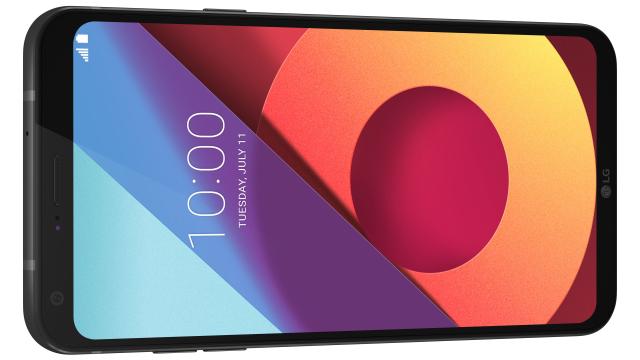We often talk about flagship phones here at Gizmodo — they’re where you’ll find the best of the best in brand new technology. Technology like super-wide full-screen displays with super-thin bezels. Thing is, though, that tech trickles down into mainstream, affordable phones — like this one. The LG Q6 is the cheapest way to get a good camera and a great screen in any new phone under $500.
What Is It?
The $399 LG Q6 is a mid-range smartphone that takes a lot of cues from the $1199 G6 announced and released earlier this year. Unlike the top of the line G6, though, the Q6 is a phone aimed at the everyperson — it’s $399 directly from LG, and cheaper elsewhere if you shop around. You could buy three for the cost of one G6, but you get a lot of the same design features trickling down — including that beautiful big display. It’s one of the best displays I’ve seen on a cheap smartphone; being 5.5 inches in size would normally mean a large phone but the 18:9 ratio and small bezels make for an extremely pocketable device.
The Q6 is built around a 5.5-inch 18:9 ratio ‘FullVision’ LCD display, with a 2160x1080pixel Full HD+ resolution. Unlike most other cheap phones out there, the Q6 has very small bezels on its sides, and appreciably small bezels top and bottom; it doesn’t look like it costs just $400 when you pick it up. Part of that perception is bolstered by the fact that it has a sturdy aluminium frame running around its perimeter, which feels impressively built. Just about the only cheap feeling part of the LG Q6 is its piano-black plastic back, which is nonremovable but looks like it should be. With a small cut-out for the rear-facing speaker on the back and the rear camera and flash up top, the back of the Q6 is basic, and while the rear plastic’s curve looks nice, I know it’s going to scratch easily.
This phone does not have the powerful octa-core Snapdragon 835 processor of the LG G6, though — that’s where the most significant cost saving has been for LG and that’s where the most significant everyday difference is for buyers. Instead, the Q6 has an entry-level, low-powered but still octa-core Snapdragon 435. If you think about Qualcomm’s mobile processor product lines as being split into the 400, 600 and 800 series, it’s like having a car with either a four-, six- or eight-cylinder engine; good, better, or best. But while the Snapdragon 435 isn’t the most powerful graphically or in raw compute performance, it’s adequate for everyday tasks. You’ll be fine checking Instagram and Facebook and browsing the ‘net and watching Netflix or YouTube on this phone.
It’s the camera of the LG Q6 that lets it down a little, not specifically for its price tag but against some of its more expensive competitors — which I’m comparing it to only because the Q6 is so impressive in its general build quality and its display, which more expensive phones use as selling points. The Q6’s 13-megapixel main rear camera takes generally clear and detailed pictures in good light, but put it indoors or try to take a picture at night, and you’ll quickly find it creates blurry and indistinct images. It has no optical image stabilisation, and its small sensor has small pixels that don’t let in a great deal of light. If a great camera is important to you, you’ll want a more expensive phone.
Despite having a low-powered processor, the Q6 is generally pretty quick to operate. The skin that LG has put on top of stock Android changes the look and feel of the operating system versus one of Google’s more vanilla phones, but the additions that it makes are, for the most part, There’s some unnecessary software duplication — why do you need your own Gallery app, LG? — but it’s easy to hide away and ignore. Battery life from the 3000mAh cell is just fine, with the Q6 easily reaching the same full-day usage stats that most phones do — you can’t expect much more than that from any phone in 2017.
Should You Buy It?
The $399 LG Q6 is a mid-range phone, but it doesn’t feel like one — and because of that, I’ve been quite hard in my judgement of it. But despite that, I’ve come away impressed — it’s hard not to be, when this relatively inexpensive phone is built around such a generally impressive display. It’s big and bright and colourful, which is everything you want, and it does all those things at a third of the price of its flagship cousin or the $1000-ish phones it’s also competing with.
The major differences that the Q6 has versus its much more expensive flagship cousin are small, but might stand out to the discerning buyer. There’s no USB Type-C, for example. It’s not water resistant. There’s no fingerprint sensor, and no dual camera. If you need any of these or want more than a couple, you’ll want to consider a more expensive phone — like the G6, if you particularly like LG’s design language. But this is a mainstream phone that does mainstream things pretty well, like the basics of watching video and browsing the ‘net.
But for a phone that does most of anything that most of anyone could want, you’ll be happy with the LG Q6. It’s a phone that proves that you don’t have to spend all your money to be impressed with what you’re buying.
